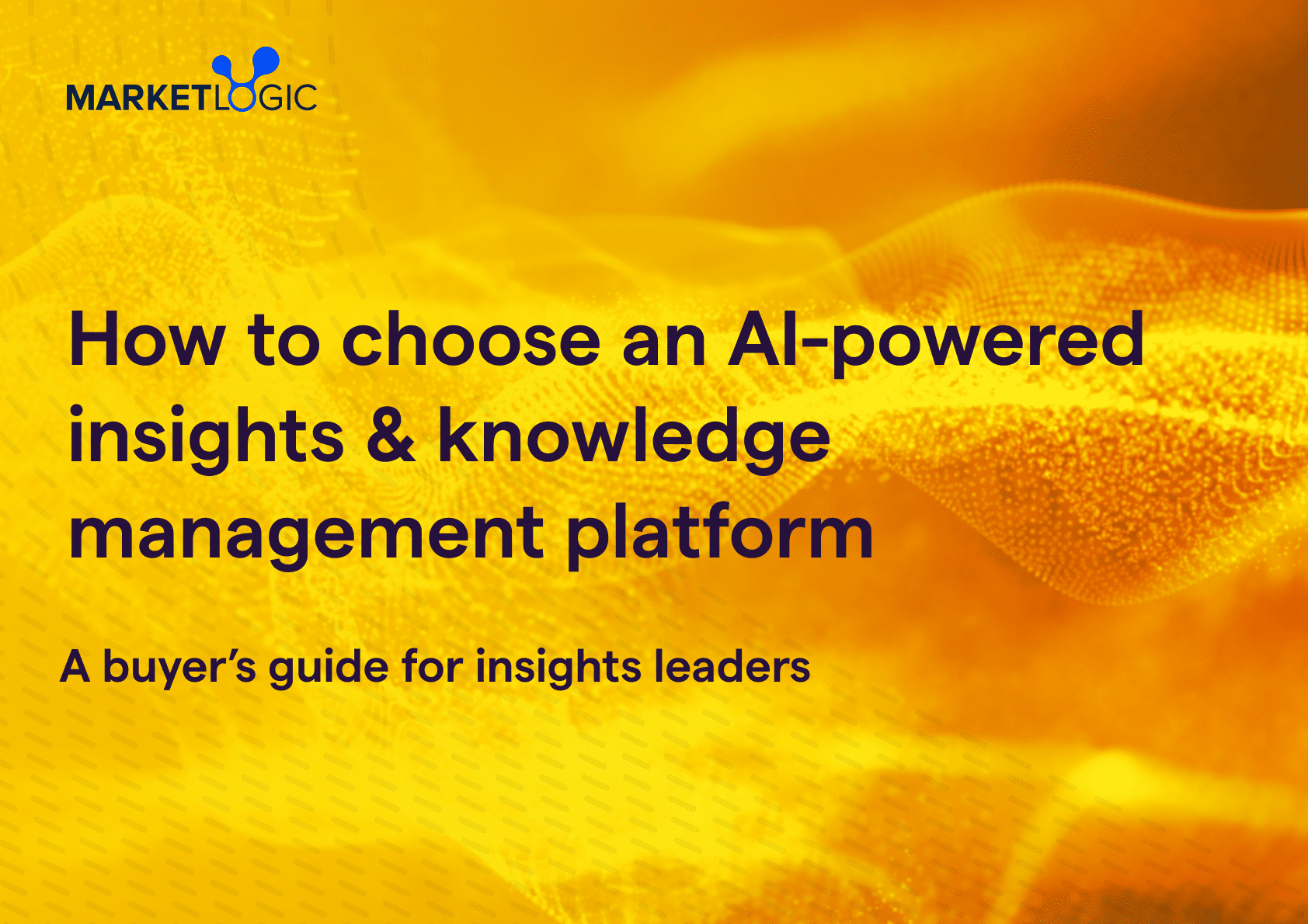A comparison between DeepSights™, Microsoft Copilot, Google Gemini, and DIY generative AI for market insights tools
If you are an insights professional conducting market research and analysis, you know how tricky it can be to get the right market insights, at the right time — and to share these quickly with the business. That’s where generative (gen AI) capabilities come in to support you in this process.
But in the ever-evolving gen AI space, you are increasingly flooded with options for market insights. It can be overwhelming to choose. For instance, you may be choosing between building an in-house Retrieval Augmented Generation (RAG) solution or investing in a proven, market-ready platform. You might already be experimenting with Microsoft Copilot or Google Gemini, which has become the default option some enterprises end up trying out.
So, when it comes to gen AI for insights, what is the difference between the available options on the market? What capabilities do you need to consider for knowledge management, and how do the platforms fare when comparing these?
Deploying the right AI solution for your organization’s market research needs is crucial. Learning what generative AI can do for you — from market research to knowledge management — and understanding the difference between gen AI market insights offerings, is crucial. To help you in your search, we break these down below.

Features to prioritize when selecting generative AI for insights market research tools
With so many generative AI solutions, whether purpose-built for market insights or more generally applicable to knowledge management offering different capabilities, narrow down contenders by focusing on the performance of the following features:
- Insights ecosystem integration: How well-connected is the platform to your entire insights data ecosystem? From insights to action, your gen AI platform should be able to pull in all your sources and easily integrate insights into any system you use. This enables insights managers to access only trusted knowledge and data in near real-time, and to flow the insights easily to the business. With Microsoft Office 365 or Google Workspace being the primary information ecosystem for enterprises, ask yourself: How easily can the AI platforms you are considering integrate with repositories like Microsoft SharePoint and Google Drive? Are out-of-the-box connections available to business tools — like Microsoft Teams, Google Chat, or Slack — which allow your colleagues to easily access the platform, wherever they work?
- Understanding market research : A major challenge in interpreting market research presentations is accurately identifying and handling different types of information, such as study background, sample descriptions, questionnaire statements, respondent quotes, research findings, and vendor pitches. An AI that doesn’t recognize these nuances can make significant errors, like mistaking questionnaire statements or individual quotes for representative data, or misinterpreting sample compositions as actual consumer numbers. For example, taking questionnaire statements (“Is a brand I liked”) or individual customer quotes (“The new package looks like a jewel box!”) for representative ground truth. Generic gen AI tools and generalist in-house platforms do not come with the built-in understanding of market research content, which could lead to missed information, or worse — misrepresentation of your valuable insights. Meanwhile, a specialized generative AI for insights platforms can now offer a deeper understanding of market research by extracting insights from a wide range of data sources and types like:
- Visual extraction: Generic gen AI tools may miss out on a vast amount of significant data. A specialized generative AI for insights platforms now goes beyond text, analyzing visual data like graphs, charts, and infographics. Recognizing that critical information is often presented visually, this new capability enables the platform to extract insights directly from these formats. By combining visual and text-based data, it delivers reliable answers to your market intelligence questions with even greater depth and accuracy.
- Multiple referenced sources: A specialized generative AI for insights platform helps you quickly gain a clear understanding of your market. By combining findings from primary, secondary, and news sources, it provides a single, cohesive response with comprehensive coverage. By streamlining information from diverse sources, it saves time, enhances clarity, and ensures you receive well-rounded, reliable insights in an easily digestible format.
- Awareness of contextual applicability: Consumer, category, brand, and market knowledge is highly context-dependent and perishable, meaning insights valid in one market or time may not apply elsewhere or later. An AI ignoring these factors may offer irrelevant information. For example, imagine an AI tool applying pre-Covid Italian consumer attitudes to present-day England. Without your context-dependent knowledge, such misunderstandings are likely to happen.

- Customer-specific context and best practices: It is crucial to customize the AI by providing customer-specific context for each business to reflect corporate context and best practices accurately. These settings include company-specific jargon, background knowledge, and guidelines on data usage. Ideally, your gen AI platform allows individual users or admins to configure such settings, enabling the AI to adapt to their specific context.
- Intuitive user experience: Does your gen AI platform effortlessly integrate complex AI processes, allowing you to input questions or problems and receive optimal responses? A design that eliminates the need for user training and includes robust interaction guardrails to prevent misuse from inadequate prompts should be prioritized.
- AI Watchouts (self-reflection about the model on the evidence and the answer): How does your platform offer features that go behind ‘answering’ questions to actually act as an Insights colleague? By highlighting inconsistencies and limitations in sources, this tool helps users quickly identify areas that may need closer attention. This proactive approach encourages critical engagement with information, empowering users to spot inaccuracies or gaps and fostering a deeper, more accurate understanding of the topics they are researching. Only specially trained Insights tools are able to provide this type of analysis of insights output. Also, how can you trust the insights provided by your gen AI platform? A number of specialized gen AI solutions feature a tool like Watchouts to flag potential issues with the underlying information. By highlighting inconsistencies and limitations in sources, this tool helps users quickly identify areas that may need closer attention. This proactive approach encourages critical engagement with information, empowering users to spot inaccuracies or gaps and fostering a deeper, more accurate understanding of the topics they are researching.
- Source selection: A specialized gen AI market insights platform lets users customize answers by choosing which sources to include or exclude, for instance, by narrowing the focus by removing sources or broadening it by adding more.
- Control Panel: A gen AI market insights solution with a user admin control center provides a centralized and easy-to-use interface for administrators, allowing them to manage the platform independently. This reduces reliance on engineering teams, streamlines administrative tasks, and enhances overall efficiency, making the platform more agile and user focused. By simplifying operations, the control center accelerates decision-making, improves resource allocation, and supports scalability. It’s a key tool for fostering a better user experience while enabling the platform to grow and adapt more effectively.
Comparing Microsoft Copilot, Google Gemini, DeepSights™, and DIY Solutions: Key differences
Now that you know some of the key features to look out for in generative AI for market insights, explore the difference between commercial solutions like Microsoft Copilot, Google Gemini, DeepSights™, and developing your own in-house (DIY) Retrieval Augmented Generation (RAG) systems. Here’s a comparison overview:
Insights ecosystem and data integration
- Microsoft Copilot and Google Gemini: Both are robust within their respective ecosystems (Microsoft Office 365 and Google Workspace), offering strong data integration capabilities. However, they may lack the necessary customization for specific market insights applications and do not typically integrate with specific external sources and partners without additional configurations. Overall, both assistants are general-purpose tools lacking the specificity needed for optimally working with market insights.
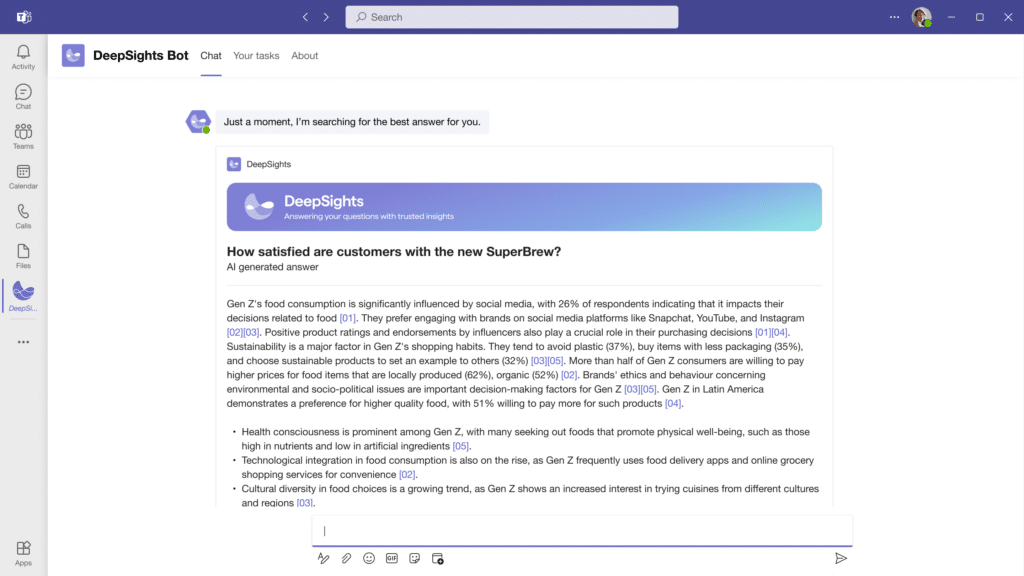
- DeepSights: Integration with Microsoft SharePoint and Google Drive ensures that all necessary content is readily accessible in your work environment, synchronized in real-time. Moreover, through integrations with everyday collaboration tools like Microsoft Teams, Google Chat, and Slack, insights are delivered right where they’re needed—in meetings and team conversations—eliminating the need to switch tools. This seamless integration not only saves time but also reduces friction and boosts productivity.
When it comes to data integration, the DeepSights platform comes with pre-integrated access to a wide range of data sources, including specialized research tools, making it easier to deploy and use immediately. More custom integrations of DeepSights into any organization’s environment can be enabled with the DeepSights API, that unifies your proprietary, paid, and public sources — and connects knowledge to business action.
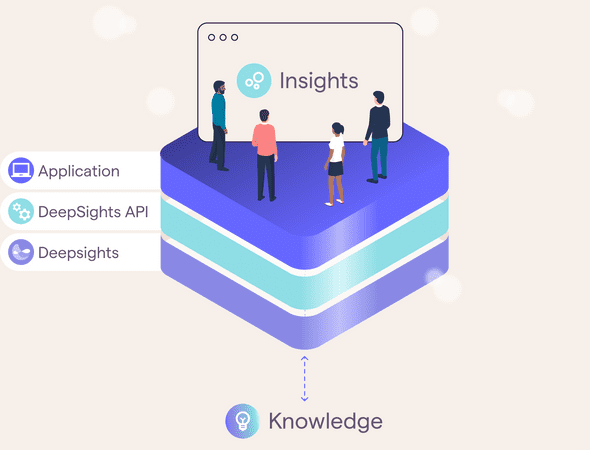
The API seamlessly integrates DeepSights outputs with downstream applications, allowing for unified, evidence-based responses across an organization’s tools. It also supports advanced content search within ingested data and streamlines document upload and download. This comprehensive functionality helps your business maximize your data’s potential, enhancing decision-making and operational workflows with minimal effort.
- DIY RAG system: Many organizations opt to build their own solutions, either tailored specifically for Market & Consumer insights content, or for general purposes across various internal knowledge repositories like HR materials, onboarding documents, sales data, and company strategy documents.
But building an in-house RAG system poses substantial challenges in integrating internal repositories with external data sources, particularly around gated or proprietary content. While accessing internal and general web content is feasible, integrating internal and external data sources in-house can be challenging. Connecting with specialized research tools and external partners demands extensive customization, development, and commercial negotiations regarding third-party content access and ongoing partner management.
2, 3 – Semantic understanding and awareness of contextual applicability
- Microsoft Copilot and Google Gemini: While both can handle user tasks and document sifting, they lack proficiency in understanding evidence and knowledge, because qualitative data interpretation poses challenges as language-based answers may conceal inaccuracies. Generic AI tools often overlook nuances in market research, target consumers, and competition, necessitating a system tailored to interpret such data accurately.
Copilot and Gemini are not bound to provide responses based on your proprietary knowledge base. Rather, they may provide responses based on web content, emails, or other internal documents it comes across in their respective environments. Additionally, Copilot does not consistently provide citations that point back to the evidence informing its responses.
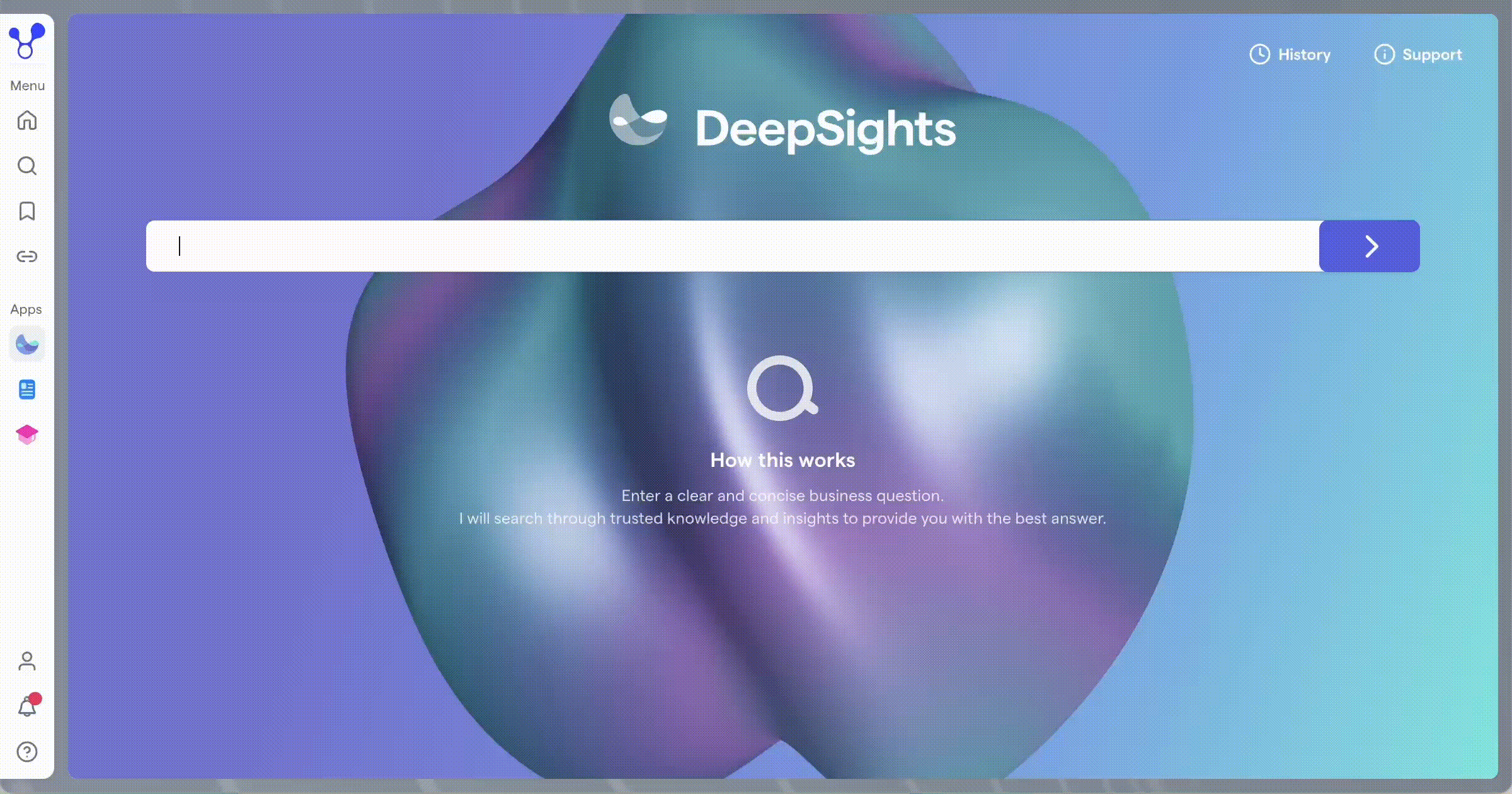
- DeepSights: Unlike generic AI tools, purpose-built AI platforms like DeepSights are adept at using best-in-class vector search capabilities for relevant findings, minimizing hallucinations and inconsistencies. By using proprietary methods to evaluate contextual relevance, including specialized evidence classifiers, DeepSights implements proprietary approaches and advanced methodologies to ensure contextual relevance and accuracy, providing high-quality insights without the need for continuous development and adjustments. It discerns relevant knowledge — leading to superior answers and actionable insights. This saves time as you can trust their accuracy in handling market insights data.
- DIY RAG system: Achieving the same level of contextual sensitivity and accuracy in an in-house system is complex and demands ongoing refinement. In our experience, in-house platforms tend to be built with generalist document ingestion in mind, in order to satisfy cross-team needs internal to the enterprise.
4. Customer-specific context and best practices
It is crucial to customize settings for each business to reflect corporate context and best practices accurately. In this case:
- DeepSights enables customers to configure such guidance to adapt the AI to their context. In addition, DeepSights allows users to tailor their answers by selecting specific sources. Users can refine the information by excluding certain sources or expand it by adding more. This customization ensures that the insights provided are aligned with a user’s specific needs.
- Microsoft Copilot and Google Gemini, on the other hand, offer no such mechanisms.
- An in-house RAG system can be an ideal solution, but is costly and time-consuming, often requiring extensive expertise and resources that many organizations lack.
5. Intuitive user experience (including implementation and expertise)
- Microsoft Copilot: Qualitative data interpretation is challenging because language-based answers can hide hallucinations and misinterpretations. In this case, Microsoft Copilot supports simple interactions and prompts but does not facilitate complex multi-stage processes.
Copilot requires users to provide detailed context and instructions through prompting techniques, necessitating training to obtain useful results. Users may inadvertently misdirect the AI with inadequate prompts. Although Copilot’s prompt library helps, it is limited to simple, single-interaction exchanges and cannot handle complex, multi-stage processes. This makes it challenging to rely on Copilot as a single-source-of-truth for obtaining answers to business questions specific to market insights that are grounded in your proprietary research and trusted, third-party sources.
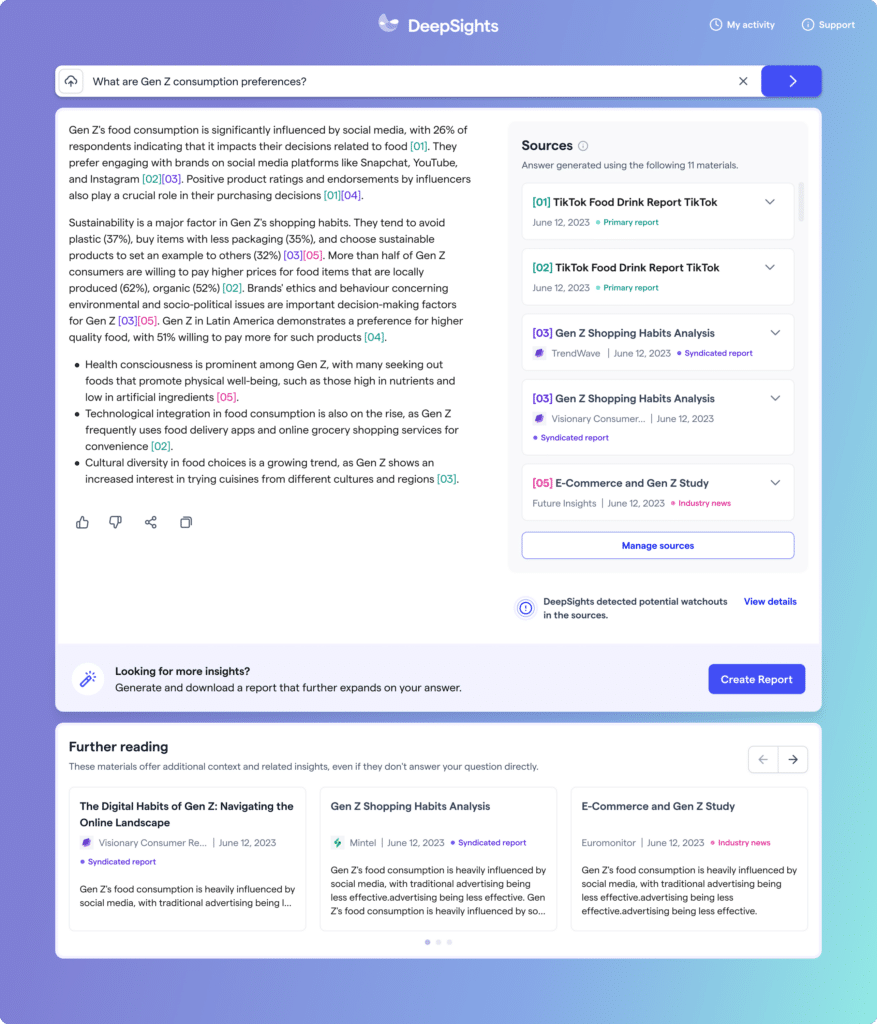
- DeepSights: Designed with user-centric principles, DeepSights provides complex, multi-stage AI processes within the product, allowing users to receive optimal responses simply by inputting their questions or problems. This design eliminates the need for user training and includes strong guardrails to prevent misuse through inadequate prompts. By simply asking business questions, users can obtain answers to business questions and optionally generate deep dive research reports. For instance, you can explore “Further Reading” material for deeper insights, ensuring a well-rounded view of the topic – and also, exclude specific sources or upload and analyze a single document to get tailored answers.
DeepSights offers a ready-to-use, sophisticated solution with built-in capabilities specifically designed for market insights, eliminating the need for extensive development and customization efforts. It encapsulates complex AI flows that require no training for users to interact effectively, ensuring strong interaction guardrails. The new DeepSights answers capability allows the incorporation of up to 5 primary sources, 3 syndicated reports, and 3 industry news, providing you with a well-rounded and reliable answer every time.
- DIY RAG system: DIY RAG-system solutions provide customization possibilities, but come with high costs and complexity attached, along with the possible additional challenge of ensuring market insights-specific customizations are introduced into generalist corporate tools. Creating a user-friendly interface that minimizes the risk of inappropriate interactions requires substantial investment in design and training.
Our tip? If you decide to develop your own solution, it is highly recommended to conduct an A/B testing exercise to compare your results with DeepSights. This will allow you to directly evaluate the performance, scalability, and integration capabilities of our platform against your in-house development. Contact your customer teams to discuss how we can support this testing. In head-to-head testing we have consistently beaten out generalist tools.
Results and tips for getting started
How do the four generative AI solutions for market insights compare?
Microsoft Copilot & Google Gemini
Microsoft Copilot is a powerful assistant for general tasks, drafting emails, and sifting through documents. While it can pull in data from all over your Office 365 environment, it lacks proficiency in understanding specific market research, and here’s the thing: it’s a general-purpose tool. It’s not specifically built to handle the nitty-gritty details of market insights and intelligence. While it offers strong integration within the Office 365 ecosystem, it lacks the market insights specificity of DeepSights™ and consumer insights understanding. This requires an AI system tailored to interpret such specialized data, such as DeepSights™ or a DIY solution.
Unlike generic AI tools, using a purpose-built AI platform — trained to meticulously scan your insights repository — avoids inconsistencies. It also reduces the need to verify results, by ensuring relevant and accurate answers.
RAG solution
While building an in-house RAG solution may appear to offer advantages, these typically do not address fundamentally important aspects when it comes to working with market insights and intelligence. Moreover, building a RAG offering is a costly and time-intensive undertaking. Most organizations do not have the know-how and expertise to build in a timely fashion and at a production-ready level, nor to invest in the keep and continual improvement of such a solution.

DeepSights
DeepSights on the other hand, offers tailored, ready-to-use capabilities specifically designed for market insights, which minimizes the need for extensive in-house development and expertise. It fully embraces and extends the Microsoft Office 365 and Google Workspace environments, including Copilot — and by using an API, DeepSights seamlessly integrates with any business application. This helps to infuse invaluable insights into your business processes — and as a result, drive better decision-making in your organization. By leveraging a SaaS platform that constantly innovates with new features and improvements through close interaction with its customers, you can future-proof your organization and stay ahead of the competition.
Conclusion
When selecting a generative AI knowledge-management tool for your tech stack, prioritize solutions that:
- Are purposely built for AI insights
- Are specifically built and trained for that purpose
- Possess architectural capabilities for interpreting data, along with providing insightful natural language processing (NLP) explanations.

If you’re looking for a generative AI for market insights tool that understands and enhances your market insights, DeepSights stands out because it is a plug-and-play solution that requires minimal training. It is designed with features that specifically address the challenges that insights professionals face, and tailored for diving deep into market data. It’s like having a specialized AI expert by your side, making your job a lot easier and more effective.
Get started today. Bring trusted generative AI insights into daily work effortlessly with DeepSights™. Transform the way you access and share insights, and how knowledge flows through the business.






